November 11, 1918. Exhausted soldiers are resting, crouched and shivering in muddy trenches under overcast skies all across northern France and Belgium. Gunfire has grown sporadic over the last 24 hours until — the words they’ve been waiting four long years for come down the line — it's over.
However, there is no cheering at this moment. Instead, there is an eerie and absolute silence. Even the larks written about by Lieutenant John McCrae (author of “In Flanders Fields”) are silent, as these men remain locked in the hollow-eyed stare of fatigue while thanking whatever gods they believe in that this war to end all wars is finally over.
In cities and towns far and wide, the cheering begins with the excited voices of those left behind in anticipation and builds gradually, with the addition of ringing church bells, into a tumultuous roar that can be heard around the world.
This scene took place 105 years ago, and during the intervening years we have set aside a few precious moments of silence on this anniversary, which we once called Armistice Day, to remember the contributions of those who came home, as well as the sacrifices of those who didn't.
It has been a way to remind ourselves that it should never happen again. But the word 'armistice' itself, contrary to popular belief, does not mean "peace." It is defined in the dictionary as "a temporary stopping of warfare by mutual agreement."
Unfortunately, “temporary” it remained. For a scant 21 years later, the rumble of the machine of world war was upon us again. The world would have to wait nearly another six years for partial silence, through the early days of May 1945, and the announcement (V-E Day) that finally came that the European phase of the Second World War had ended.
V-J Day a few months later held its own special 'final silence' as people all over the world looked on in horror at the newsreels of the twin atomic bomb destruction of Hiroshima and Nagasaki.
And, since that time, “The War to End All Wars” (another name for the First World War) has remained the misnomer to end all misnomers, as we have joined with our veterans every November in mourning those who have not returned from the countless wars and conflicts that have continued to wreak havoc on our society.
Armistice Day, or Remembrance Day as it is now known, originated following the end of the First World War. The Armistice agreement was signed between Germany and the Allied Forces in Paris on Monday, November 11, 1918, at 5 a.m. The ceasefire went into effect at 11 a.m. that same morning.
The eleventh hour of the eleventh day of the eleventh month.
A short five months later, in April of 1919, Liberal MP Isaac Pedlow introduced legislation in the House of Commons to provide for an annual Armistice Day. All members of the House agreed that setting aside a day to honour the war dead was of the highest importance.
However, some disagreed on whether that day should be fixed as the 11th of November. Pedlow cited support from business groups that a day of remembrance should instead be held on a designated Monday in November and not specifically on the 11th so as not to inconvenience businesses and employers.
Unfortunately, another member of the House was successful in delaying the discussion on the bill for six months. The House never resumed discussion of the proposal.
On Nov. 6, 1919, in honour of the first anniversary of Armistice Day, then acting Prime Minister Sir George Foster (Sir Robert Borden had gone on an extended vacation) read a message from King George V addressed “to all peoples of the Empire”.
The following is his letter:
“To all my people: Tuesday next, November 11th, is the first anniversary of the Armistice which stayed the world-wide carnage of the four preceding years, and marked the victory of right and freedom. I believe that my people in every part of the Empire fervently wish to perpetuate the memory of that great deliverance and of those who laid down their lives to achieve it.
“To afford an opportunity for the universal expression of this feeling it is my desire and hope that at the hour when the Armistice came into force, the eleventh hour of the eleventh day of the eleventh month, there may be for the brief space of two minutes, a complete suspension of all our normal activities. During that time, except in rare cases where this may be impractical, all work, all sound and all locomotion should cease, so that in perfect stillness the thoughts of every one may be concentrated on reverent remembrance of the glorious dead.”
In 1921, the Unionist government of Prime Minister Arthur Meighen, introduced legislation to establish Armistice Day formally as a legal holiday. Section 2 of The Armistice Day Act 1921 provided that every year, on the Monday in the week that the 11th of November fell, should be kept as a legal holiday under the name of “Armistice Day”. Section 3 of the same act provided for a “Thanksgiving Day” to be held on that same date.
So, from 1921 to 1931, Canada observed both Armistice Day and Thanksgiving Day on the same date each year.
In 1931, an independent MP from British Columbia, A.W. Neill, introduced The Armistice Day Amendment Act. His bill repealed Sections 2 and 3 of “The Armistice Day Act” and substituted a clause which fixed Nov. 11 as Armistice Day. Thanksgiving Day was returned to the practice that existed prior to 1921 wherein the date was fixed at the government’s whim.
Now that we’ve gotten the story of the origins of Remembrance Day out of the way, let us look closer at some of the activities which took place in the Sudbury Region over the years as it relates to the end of both the First and Second World Wars and Remembrance Day ceremonies.
On Nov. 11 1918, after more than four years of fighting, Armistice Day was marked in Sudbury by celebrations that began at about 3 a.m., gradually gaining momentum by daybreak. A huge bonfire lit up the corner of Elm and Durham streets as hundreds of people gathered to celebrate. Anything that was not tied down served to enhance the bonfire. The total damages were reported at $30,000.
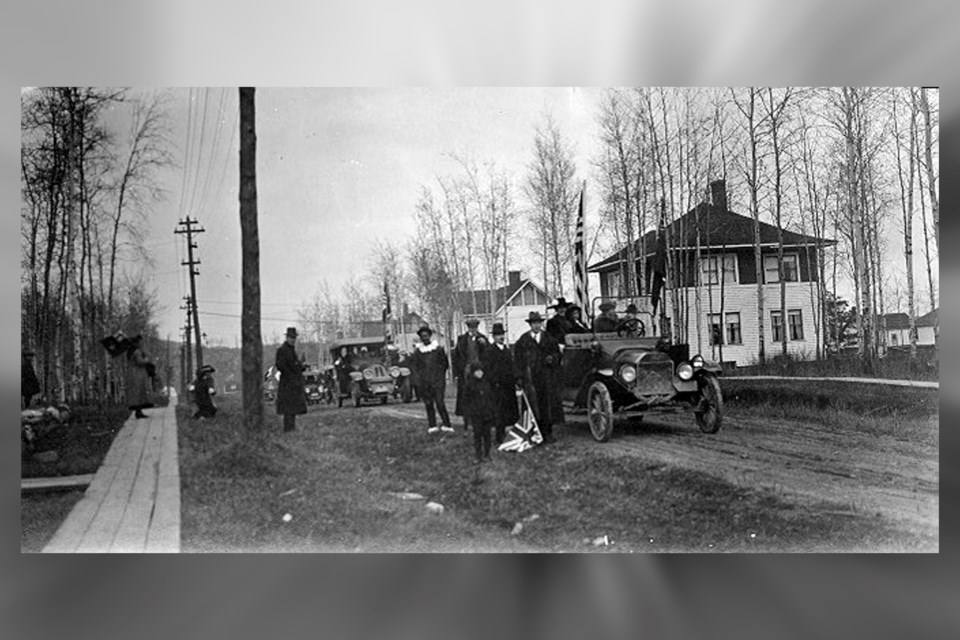
By comparison, a short distance away, the Village of Coniston was found to be celebrating the Armistice with a parade of what appears to be four or five vehicles and two dozen people, some of whom are waving the Union Jack and others Canadian Red Ensign (our flag at the time).
In 1928, Sudbury’s first Cenotaph was constructed in memory of those who gave their lives during the Great War (the First World War). It was unveiled and dedicated on Aug. 20, 1928, by General A.H. Bell. The cenotaph at the corner of Lorne and Elm Streets was erected on the courthouse lawn in what would have been considered at the time to be a highly visible (and important) location. The front of the cenotaph has two copper plaques, the lower of the two includes a paraphrasing of the last four lines of Alfred Edward Housman’s poem “XXXII. When I would muse in boyhood" published in 1922:
“They braced their belts about them,
And crossed in ships, the sea.
They fought, and found six feet of ground,
And died for you and me.”
The base (which contains the dates “1914-1918” in the centre) is bordered by the names of the first and last battles fought by the Canadian Expeditionary Force (CEF) during the War (Ypres & Mons). The stele monument itself is made up of five stone blocks that become progressively smaller as they rise in the air. On the left and right sides of each block are the names of 10 major battles in which the CEF fought (including the most famous of them all, Vimy).
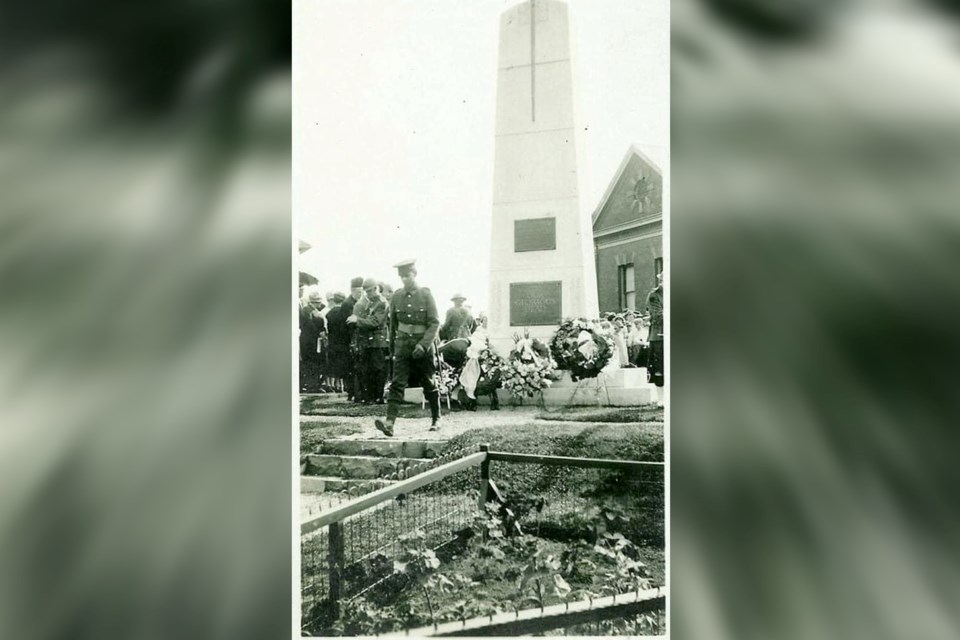
Due to its proximity to what eventually became a busy intersection, it is no longer used for any Remembrance Day Services. However, wreaths are placed there regularly by Legion members.
On Nov. 11 1939, great honour was paid to the dead of the First War at the Remembrance Day service conducted at this Cenotaph. Most likely owing to the fact that it was held shortly after the beginning of the Second World War, it was reported at the time that this ceremony was the largest attended up to that date in Sudbury.
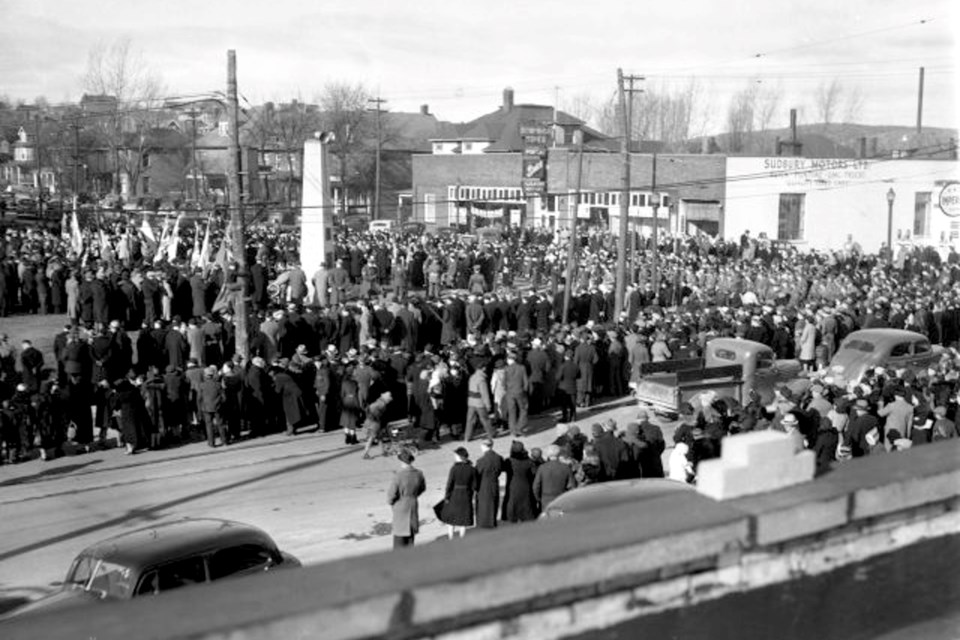
On May 8, 1945 (the day after VE Day and an official holiday), more than 2,000 people marched in the Victory parade that proceeded to Queen's Athletic Field, with almost all civilian and military units being represented. En route to the park the parade paused at the Cenotaph for a brief memorial tribute to those who would not return from overseas, and at the field, speakers lauded all branches of the war effort.
A massed band and choir led the community in singing. It was estimated that 10,000 people were at the field for the opening of the ceremonies, although many left early on account of the bitter wind.
Later that month, on May 24, under sunny skies in Copper Cliff, public school pupils, Brownies, Girl Guides, Cubs, Boy Scouts, the Highland Cadets (with bugle band) and Sea Cadets marched smartly in a parade that was routed around Nickel Park.
The official end of the Second World War on VJ Day, Aug. 14, 1945, also marked the repetition of a shameful night in the history of Sudbury (remember the reaction on Armistice Day written about above). When news reached the city that Japan had officially surrendered, happy celebrants gathered in the downtown area and soon a huge bonfire was lit (again) at the corner of Elm and Durham Streets.
Addressing an audience of 5,000 in Sudbury, Mayor W.S. Beaton struck the keynote for the momentous occasion when he said, "There are too many broken hearts, too many vacant chairs, to warrant abandoned jubilation. In this final victory we must pay acknowledgment to Almighty God, that He has sustained the Canadian nation and our Allies through almost six years of warfare and brought our cause to a victorious conclusion."
Mayor Beaton urged the gathering to remember the service and sacrifice of all Sudbury citizens, with the sincere hope and prayer that the final victory would mean that all peoples, and all nations, large and small, might live in freedom, peace and security in the future.
Unfortunately, after Beaton’s address, anything that could burn was thrown into the fire, a new boat that was being raffled off by a local club was stolen and rioters even tried to overturn a streetcar. The fire department was asked to restore order using water streams to disperse the celebrants who were looting the liquor store. Over $40,000 damage to property was done and 28 men were arrested.
Sudbury's riot was the only one in Canada to mark VJ Day.
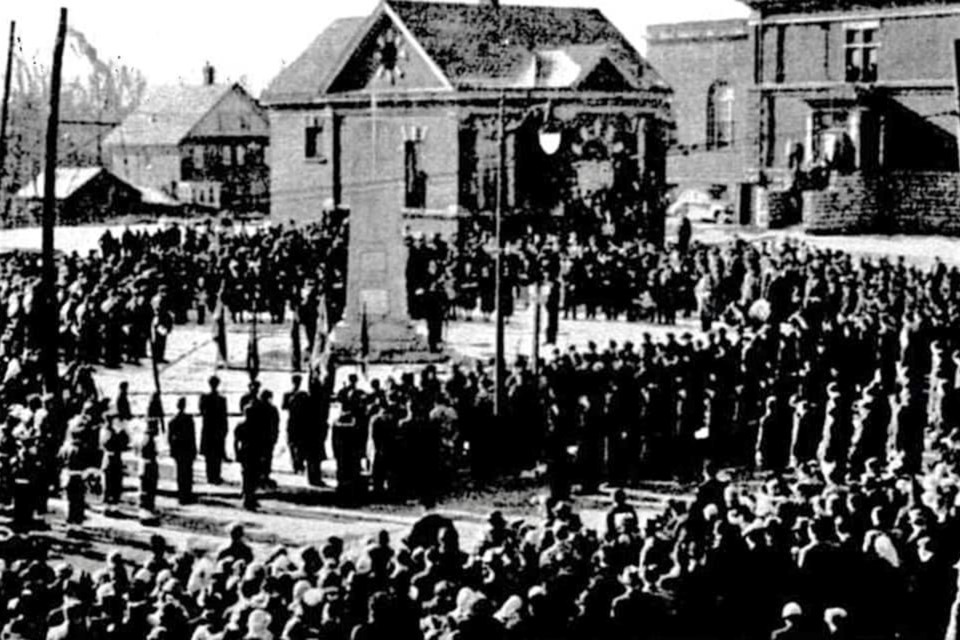
A short five years after the end of the Second World, at Sudbury's observance of the 32nd anniversary of the Armistice of 1918, Legion President Nick Kyrzakos stood at the corner of Elm and Lorne Streets on a crisp Nov. 11 morning in 1950 and proudly proclaimed, “The Legion of the Living salutes the Legion of the Dead.”
Three hundred members of the Canadian Legion, gathered around the cenotaph, replied in unison, "We will not break faith with ye." With this pledge of remembrance, the men who came back saluted the men who gave their lives for freedom in two world wars.
A large congregation of citizens took part in the services. The 58th Sudbury L.A.A. Regimental Band played for the ceremony while cadets of the army, navy, and air force, and representatives of many Sudbury service organizations and societies, marched in an impressive parade to the cenotaph, along with 70 First World War veterans, 50 veterans of the Polish army, and almost 200 Second World War veterans.
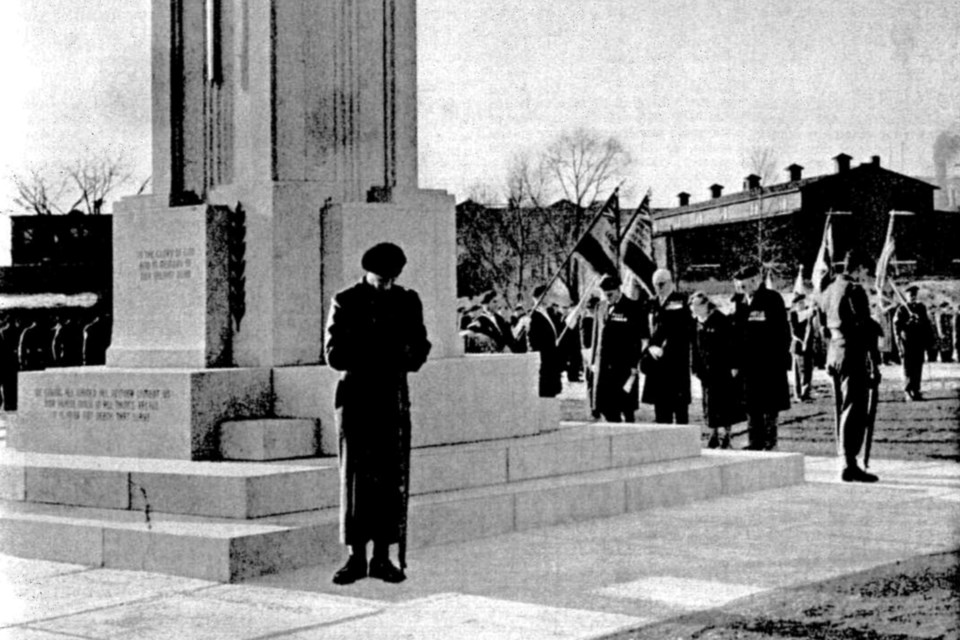
In 1957, a new Cenotaph was constructed in Memorial Park in memory of the 575 citizens of the Sudbury area who paid the supreme sacrifice in both the First and Second World Wars and in the Korean War. The official unveiling and dedication took place Nov. 10, 1957. The first wreaths were laid by the National Defence Minister Randolph Pearkes (also a Victoria Cross recipient from the First World War), and Mrs. F.C. Lane, a Silver Cross Mother who lost two sons in World War II.
When plans were started for a new Cenotaph in Memorial Park, the area around the site was redesigned and landscaped as a project of the Sudbury Lions Club and the City of Sudbury. The Cenotaph was constructed by Royal Canadian Legion Branch 76, at a cost of $16,000. It is made of granite, stands 19 feet tall, weighs 50 tons, and rests on a two-foot-thick, 18-feet-square base.
A poem composed by Rudyard Kipling for Branch 76 in 1928 is inscribed on the monument: "We, giving all, gained all, neither lament us nor praise, only, in all things recall — it is fear, not death that slays."
Remembrance Day ceremonies were held at this Cenotaph every year until 1985 when services began to be held in the Sudbury Arena. However, wreaths would always be placed on the Cenotaph on Remembrance Day and throughout the year.
The same tribute to the fallen warriors of World War One by Kipling that is mentioned above was also inscribed on a memorial plaque housed in the old Branch 76 building on Frood Road, which was sold to the United Steelworkers of America in 1965. Fearing that the cracked base of the inscription would disintegrate with any movement, Legion officials left it in the Steelworkers Hall.
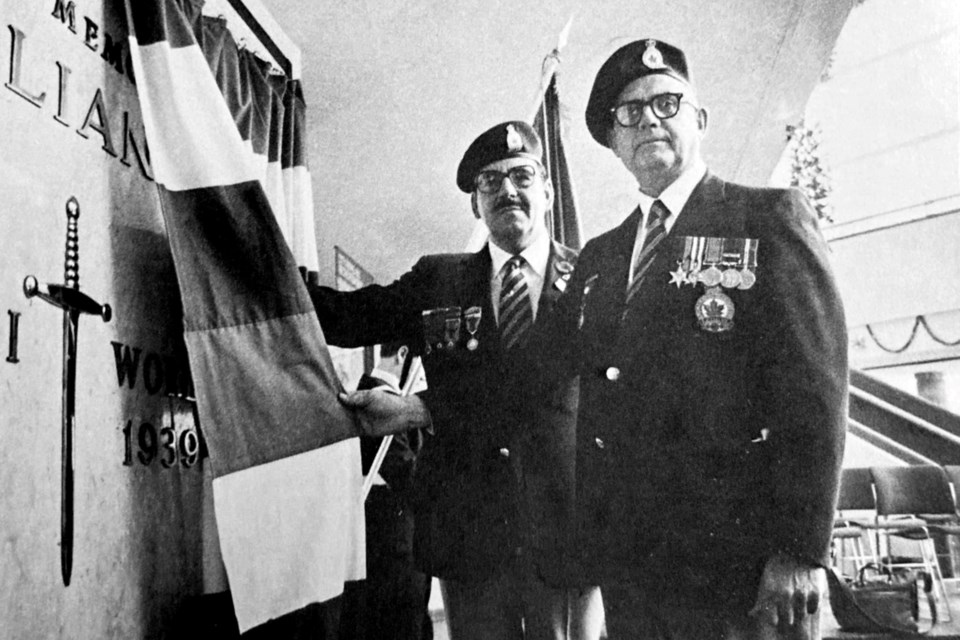
The letters were eventually removed and set onto a new marble base in 1972. A special memorial committee chaired by Bert Guillet, a past president of Branch 76, investigated a number of possibilities and found that Civic Square (now Tom Davies Square) would be the appropriate place to install this memorial.
"It is the most appropriate place we could find," commented Guillet at the time. "The public has access to it and we have a number of visitors from out of town and out of the country who visit there."
In early 1982, more than 75 Legion members, as well as local dignitaries, attended a ceremony at Civic Square to dedicate the memorial. It, along with a book containing the names of Sudbury’s deceased soldiers from the First and Second World Wars and the Korean War, remains in the lobby of Tom Davies Square to this day.
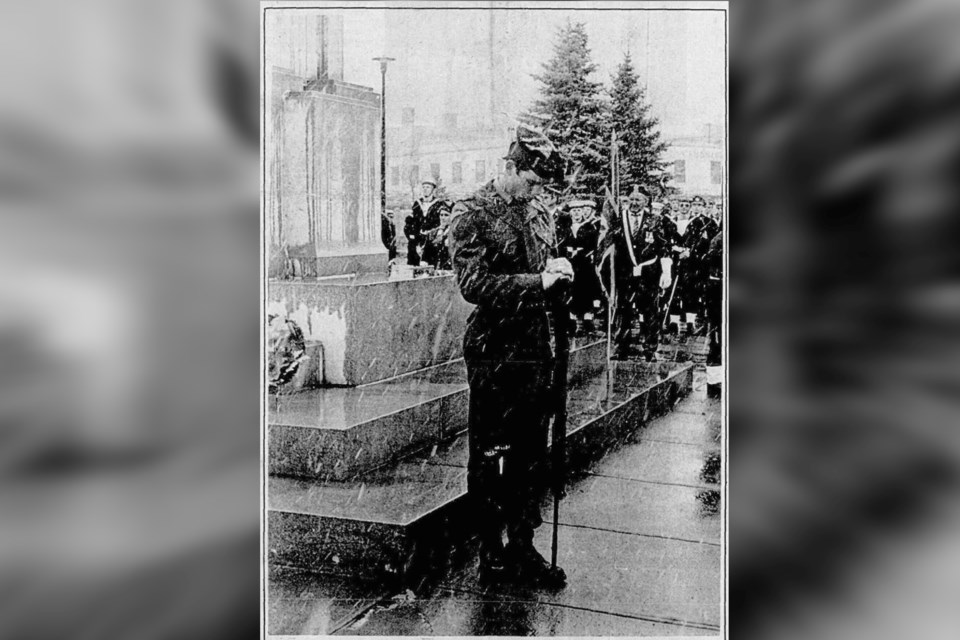
Well dear readers, this week’s column is done and now I throw the torch to you (though not from failing hands) to hold on high. Whether you are a veteran (or the relative of one), a Legionnaire, or one among the vast groups of school children and adults who have participated in the Act of Remembrance, now is your turn to share with us the memories that you have of Remembrance Days past and what it means to you.
Moreover, this Nov. 11, I ask you all to join with your fellow citizens at one of our local ceremonies to reflect and to fill the silence with a fervent prayer for peace. Share your memories or photos by emailing Jason Marcon at [email protected] or the editor at [email protected].
Jason Marcon is a writer and history enthusiast in Greater Sudbury. He runs the Coniston Historical Group and the Sudbury Then and Now Facebook page. Memory Lane is made possible by our Community Leaders Program.